The Health Benefits of Tapioca
-
With the ever-increasing popularity of gluten-free baking, Tapioca flour has become an important ingredient in the kitchen for many people. Cassava roots, from which Tapioca is derived, are naturally high in carbohydrates. And it is precisely for this reason that tapioca starch can be made. This is processed into gluten-free flour or (so-called) pearls and flakes. These ingredients are used as a thickener in a variety of foods, from pizza dough to pie filling.
-
With the ever-increasing popularity of gluten-free baking, Tapioca flour has become an important ingredient in the kitchen for many people. Cassava roots, from which Tapioca is derived, are naturally high in carbohydrates. And it is precisely for that reason that tapioca starch can be made from it. This is processed into gluten-free flour or (so-called) pearls and flakes. These ingredients are used as a thickener in a variety of foods, from pizza dough to pie filling.
-
Tapioca tastes mild and has a slightly sweet taste. It is one of the purest forms of starch available. In addition to carbohydrates and starches, Tapioca is very low in other nutrients such as proteins, fats, and most vitamins and minerals. On the other hand, Tapioca is completely gluten free, low in calories and completely free from sugar. So despite the lack of essential nutrients, which you would expect from Tapioca, this product is excellent for use in healthy, gluten-free cooking and baking.
How is Tapioca made?
-
How exactly Tapioca is made differs per location. But basically it's always about squeezing the starchy liquid from the Cassava root.
-
 11 minMain dishpeanut oil, tofu stir-fry cubes finely seasoned, stir fry sauce sweet and sour, thick noodles, carrot julienne, beetroot julienne, yellow bell pepper, watercress,rainbow salad with tofu
11 minMain dishpeanut oil, tofu stir-fry cubes finely seasoned, stir fry sauce sweet and sour, thick noodles, carrot julienne, beetroot julienne, yellow bell pepper, watercress,rainbow salad with tofu -
 45 minMain dishRed cabbage, mild olive oil, quinoa plus, forest outing, lemon, sesame oil, soy sauce less salt, Bio Today tahini white in pot, tap water,grilled red cabbage with quinoa salad
45 minMain dishRed cabbage, mild olive oil, quinoa plus, forest outing, lemon, sesame oil, soy sauce less salt, Bio Today tahini white in pot, tap water,grilled red cabbage with quinoa salad -
 30 minDessertBrie, Roquefort, port salut, gruyere, Camembert, walnut, garlic, thyme, honey, grape, baguette, Red onion, red grape, raisins, Red wine, Red wine vinegar, Brown sugar,generous cheese plate with onion marmalade
30 minDessertBrie, Roquefort, port salut, gruyere, Camembert, walnut, garlic, thyme, honey, grape, baguette, Red onion, red grape, raisins, Red wine, Red wine vinegar, Brown sugar,generous cheese plate with onion marmalade -
 30 minDessertFull Milk, whipped cream, macaroon, custard powder, vanilla sugar, sugar, protein, amaretto, almond liqueur, basic recipe cooking pears,macaroon pastry with casserole
30 minDessertFull Milk, whipped cream, macaroon, custard powder, vanilla sugar, sugar, protein, amaretto, almond liqueur, basic recipe cooking pears,macaroon pastry with casserole
-
Once the starchy liquid has been extracted from the roots, the water is allowed to evaporate. After this process, very fine powder remains. That's the Tapioca.
-
Once the starchy liquid has been removed from the roots, the water is allowed to evaporate. After this process, very fine powder remains. That's the Tapioca.
-
This powder is then processed into the desired shape. It could be flour, pearls, or flakes.
-
Tapioca in the shape of pearls is the most common form. They are often used in teas, puddings, and desserts. But also as a thickening agent in cooking.
-
 5 minDrink without alcoholbananas, cool fresh apple-pear raspberry juice, Soy drink vanilla,soy fruit shake
5 minDrink without alcoholbananas, cool fresh apple-pear raspberry juice, Soy drink vanilla,soy fruit shake -
 20 minMain dishsauerkraut, sticking potato, liquid baking product, half-to-half minced, Spice meatballs, pineapple, olive oil, liquid baking product,gratin sauerkraut dish with minced meat
20 minMain dishsauerkraut, sticking potato, liquid baking product, half-to-half minced, Spice meatballs, pineapple, olive oil, liquid baking product,gratin sauerkraut dish with minced meat -
 40 minMain dishlemongrass, fresh ginger, Red peppers, onions, tomato cubes, fresh cod fillet, coriander, oil, ground turmeric (koenjit), coconut milk, salt,fish in creamy coconut sauce
40 minMain dishlemongrass, fresh ginger, Red peppers, onions, tomato cubes, fresh cod fillet, coriander, oil, ground turmeric (koenjit), coconut milk, salt,fish in creamy coconut sauce -
 15 minSide dishsweet potato, soft goat cheese, egg, spring / forest onion,stuffed sweet potato with egg
15 minSide dishsweet potato, soft goat cheese, egg, spring / forest onion,stuffed sweet potato with egg
-
Since all the water has been extracted from the Tapioca, the purchased Tapioca must first be soaked or boiled before consumption.
-
During this process, the size of the pearls or flakes doubles, becoming slightly translucent.
-
Tapioca is often confused with cassava flour. While Tapiova is made from the root of the Cassava, cassava flour is made from the flower of the same plant. Two completely different products!
-
 20 minMain dishTasty vine tomato, (olive oil, fresh basil, onion, garlic, Parmigiano Reggiano, zucchini spaghetti, pumpkin spaghetti, mini buffalo mozzarella,lukewarm pumpkin and zucchini spaghetti
20 minMain dishTasty vine tomato, (olive oil, fresh basil, onion, garlic, Parmigiano Reggiano, zucchini spaghetti, pumpkin spaghetti, mini buffalo mozzarella,lukewarm pumpkin and zucchini spaghetti -
 15 minSide dishtraditional olive oil, curry powder, wheat flour, coconut milk, sambal oelek, chicken broth tablet, water, fresh mango,curry sauce with mango
15 minSide dishtraditional olive oil, curry powder, wheat flour, coconut milk, sambal oelek, chicken broth tablet, water, fresh mango,curry sauce with mango -
 30 minMain dishtraditional olive oil, lean ground beef, frozen Mexican wok vegetables, salsa sauce mild, taco shell, grated young cheese, creme fraiche,Mexican vegetable in tacos
30 minMain dishtraditional olive oil, lean ground beef, frozen Mexican wok vegetables, salsa sauce mild, taco shell, grated young cheese, creme fraiche,Mexican vegetable in tacos -
 95 minMain dishmaize chicken, lemon, coarse sea salt, pepper, extra virgin olive oil, garlic, thyme, zucchini, tomatoes (small to), black olives without pit,provençal chicken with zucchini and tomatoes
95 minMain dishmaize chicken, lemon, coarse sea salt, pepper, extra virgin olive oil, garlic, thyme, zucchini, tomatoes (small to), black olives without pit,provençal chicken with zucchini and tomatoes
What is Tapioca used for?
-
Tapioca is a grain and gluten free product that has many uses:
-
Tapioca flour can be used very well to make bread. But in most cases it is used in combination with another flour. So a mix.
-
Tapioca flour is very often used to make unread bread, especially in developing countries. Which is not surprising: It is available locally and is very cheap.
-
Tapioca flour is very often used to make unread bread, especially in developing countries. And this is not surprising: It is available locally and is very cheap.
-
With different toppings, this unleavened bread can also be used for breakfast, lunch or dessert.
-
The Tapioca, in the shape of pearls, is very often used to make puddings, desserts, snacks, or tea.
-
Tapioca is also an excellent binding agent for soup, a delicious sauce, or a gravy. It is a cheap binder, high thickening power, and has a neutral taste.
-
 25 minSmall dishflour, frozen puff pastry, egg, milk, walnut, mature cheese, paprika, dried Provençal herbs,puff pastry-sticks
25 minSmall dishflour, frozen puff pastry, egg, milk, walnut, mature cheese, paprika, dried Provençal herbs,puff pastry-sticks -
 20 minSide dishEggs, lettuce, parsley, olive oil (extra virgin), tarragon vinegar, salt and freshly ground pepper,lettuce with egg dressing
20 minSide dishEggs, lettuce, parsley, olive oil (extra virgin), tarragon vinegar, salt and freshly ground pepper,lettuce with egg dressing -
 15 minSmall dishbaking flour, peanut oil, flat leaf parsley,ar'nabit mi'li
15 minSmall dishbaking flour, peanut oil, flat leaf parsley,ar'nabit mi'li -
 15 minAppetizerScottish salmon fillet, butter or margarine, fresh dill, creme fraiche, dry white wine, arugula lettuce melange, pan tostado,baked salmon with white-wine sauce
15 minAppetizerScottish salmon fillet, butter or margarine, fresh dill, creme fraiche, dry white wine, arugula lettuce melange, pan tostado,baked salmon with white-wine sauce
-
Tapioca is also used as a binding agent in making burgers and all kinds of doughs, for example, to improve texture and moisture content. Also important for retaining moisture in a gel-like form. And did you know that Tapioca also helps to prevent discoloration for as long as possible?
-
Besides the fact that Tapioca is of course often used in cooking and baking, it is also a useful agent for washing clothes. Adding the Tapioca pearls will ensure cleaner laundry.
-
Besides the fact that Tapioca is of course often used in cooking and baking, it is also a useful agent for washing clothes. Adding the Tapioca pearls will ensure cleaner wax.
The nutritional value of Tapioca
-
Tapioca is a starch extract made from the starchy Cassava root. Today, Cassava is grown in much of Africa, Asia, and South America. The whole plant is considered in those parts of the world as an important commodity that provides millions of people with a significant portion of their calories. (1)
-
Tapioca is a starch extract made from the starchy Cassava root. Today, Cassava is grown in much of Africa, Asia, and South America. The whole plant is considered an important commodity in those parts of the world, providing millions of people with a significant portion of their calories. (1)
-
 25 minMain dishbalsamic vinegar, garlic, steak, Spaghetti, traditional olive oil, fresh green olive tapenade, arugula, Parmigiano Reggiano,spaghetti with steak and arugula
25 minMain dishbalsamic vinegar, garlic, steak, Spaghetti, traditional olive oil, fresh green olive tapenade, arugula, Parmigiano Reggiano,spaghetti with steak and arugula -
 15 minAppetizerfennel bulb, arugula, red pointed pepper, black agnus carpaccio (a 100 grams), capers,black angus carpaccio with fennel
15 minAppetizerfennel bulb, arugula, red pointed pepper, black agnus carpaccio (a 100 grams), capers,black angus carpaccio with fennel -
 35 minMain dishsweet potatoes, salad onion, garlic, cooking dairy, grated cheese for vegetable gratin, almond shavings, peanut oil, breaded schnitzels, Broccoli,crispy schnitzel with sweet potato gratin and broccoli
35 minMain dishsweet potatoes, salad onion, garlic, cooking dairy, grated cheese for vegetable gratin, almond shavings, peanut oil, breaded schnitzels, Broccoli,crispy schnitzel with sweet potato gratin and broccoli -
 30 minMain disholive oil, onion, tomato, risotto rice, laurel leaf, thyme, saffron, turmeric, fish stock of 1 tablet, mixed seafood, mixed whitefish fillet, mussel, lemon,fish paella from the oven
30 minMain disholive oil, onion, tomato, risotto rice, laurel leaf, thyme, saffron, turmeric, fish stock of 1 tablet, mixed seafood, mixed whitefish fillet, mussel, lemon,fish paella from the oven
-
So, what exactly is in a quarter cup of tapioca flour? Let's sum up the (short) list (2):
-
But, if there are so few nutrients in it… why would you use it anyway?
-
While Tapioca will provide you with few essential nutrients, using Tapioca allows you to make recipes such as puddings, sauces, and other goodies without using other highly processed ingredients. nts and strange additions. Just read the ingredient list on a simple product like pudding. You could throw 80% of those strange additions aside if you were using Tapioca.
-
In some parts of the world, Tapioca flour is even used to make bread, cake, cookies, chips, and tortilla. It also makes a kind of milky drink, which you could compare to coconut milk.
The benefits of Tapioca
-
If you have an allergy to nuts, coconut, or any other gluten-free grains. Or if you follow a low FODMAP diet, you will find that Tapioca can mean a lot for you.
-
Some Health Benefits of Using Tapioca (flour, pearls or flakes) in baking and cooking
-
There is one reason why people love Tapioca when they follow the successful Paleo diet: It is free from gluten, grain, cereal dairy, and seed. And also almost sugar free. Tapioca is also completely vegan! How beautiful do you want it? Cassava products are easily digestible and are often recommended for people with digestive problems such as celiac disease, gluton intolerance, nut or seed allergies, diverticulitis, IBS or IBD.
-
Tapioca flour is a very nice alternative to traditional wheat flour. But that's not all. It is also an alternative to flour that can be used for all kinds of purposes. It can even replace nut-based flour, such as almond flour.
-
It has a variety of uses in healthy baking and cooking, without any unwanted additives or gluten. In most cases, tapioca can be eaten normally by people with a sensitive digestive system, or by people who have other difficulties in eating other products based on other flours.
-
Tapioca is even safe for people who follow a moderate form of the autoimmune diet, a diet that limits many sources of carbohydrates. (3)
-
Tapioca has relatively more carbohydrates and water than many other types of flour, such as buckwheat, rice, corn, almond, and coconut flour. (4) Being low in protein, sugar or fat, it is very low in calories and can be used in many recipes if you want to lose weight and / or balance your weight.
-
Using Tapioca in cooking and baking can be a great way to keep the use of butter, oil, cream, or dairy to a minimum. It is suitable for people on a low-calorie diet, people with diabetes, people with symptoms of high blood pressure, high cholesterol, allergies, and digestive problems.
-
You won't even notice that you've used Tapioca in your food. It is completely odorless and tasteless. Therefore, it can be used in both sweet and savory dishes. The use of Tapioca has a positive effect on the texture and the so-called â € mouthfeelâ € ™.
-
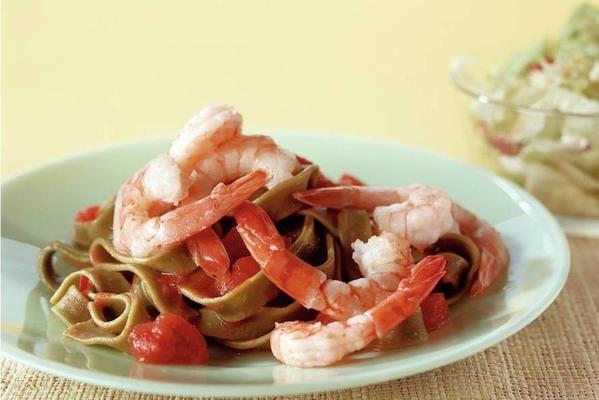 15 minMain dishgreen tagliatelle, garlic, Red pepper, olive oil, tomato cubes, cocktail shrimp, mixed salad, vinaigrette,spicy tagliatelle with shrimps
15 minMain dishgreen tagliatelle, garlic, Red pepper, olive oil, tomato cubes, cocktail shrimp, mixed salad, vinaigrette,spicy tagliatelle with shrimps -
 50 minMain dishsomething crumbly potatoes, sauerkraut natural, tomato paste, sambal oelek, bacon, semi-skimmed milk, unsalted butter, Gelderse smoked sausage,Sauerkraut with smoked sausage
50 minMain dishsomething crumbly potatoes, sauerkraut natural, tomato paste, sambal oelek, bacon, semi-skimmed milk, unsalted butter, Gelderse smoked sausage,Sauerkraut with smoked sausage -
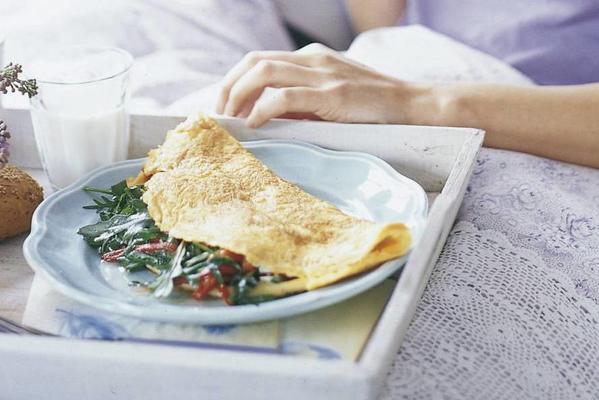 20 minBreakfastrucola lettuce, bunch onion, roasted red peppers in pot, traditional olive oil, medium sized egg, fresh cream, grated mature cheese, butter,creamy cheese omelet with arugula
20 minBreakfastrucola lettuce, bunch onion, roasted red peppers in pot, traditional olive oil, medium sized egg, fresh cream, grated mature cheese, butter,creamy cheese omelet with arugula -
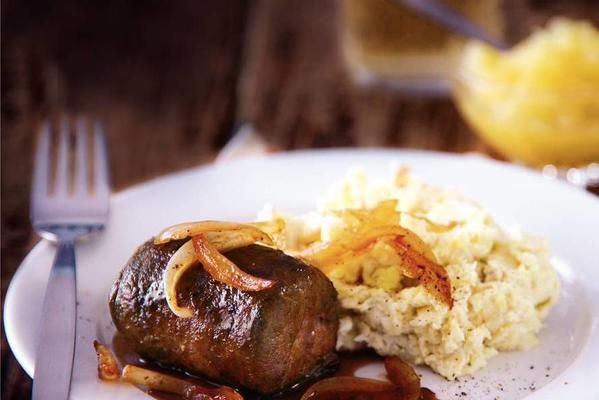 25 minMain dishceleriac, floury potatoes, olive oil, beef finches, onion, Apple juice, gravy natural, dairy spread,beeffinch with sweet apple gravy
25 minMain dishceleriac, floury potatoes, olive oil, beef finches, onion, Apple juice, gravy natural, dairy spread,beeffinch with sweet apple gravy
-
If you don't like the taste of other gluten-free grain flours, using Tapioca will blow your mind. Just give it a try and you'll be amazed!
-
Compared to many other types of flour, Tapioca is absorbent and retains any water well. In practice, this means that it can be used perfectly as a binding agent. While gluten-free baking can sometimes be very tricky without the binding and resilient quality of gluten, adding Tapioca can help prevent products from becoming too dry and from forming a homogeneous mass.
-
Of course it will not rise like yeast, which means that it will not always be a success if you use it in bread, for example. But it certainly has better binding properties than almond or coconut flour.
-
Tapioca is cholesterol slurry. As you probably know, high cholesterol can cause problems with your blood vessels. They will silt up, which can sooner or later cause problems with, among other things, your heart. In the worst case, a heart attack or a stroke.
-
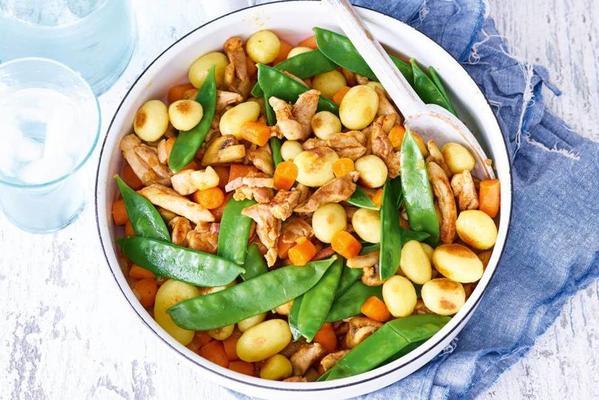 25 minMain dishthin bacon strips, onion, chicken fillet, smoked paprika, chestnut mushrooms, traditional olive oil, chilled little newborns, fresh carrots and snow peas,free-range chopsticks with mixed vegetables
25 minMain dishthin bacon strips, onion, chicken fillet, smoked paprika, chestnut mushrooms, traditional olive oil, chilled little newborns, fresh carrots and snow peas,free-range chopsticks with mixed vegetables -
 15 minSnackflatbread, Mango Chutney, smoked duck breast, cress,oriental duck
15 minSnackflatbread, Mango Chutney, smoked duck breast, cress,oriental duck -
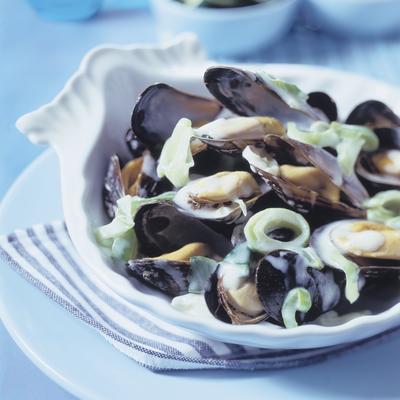 20 minMain dishmussel, butter, leeks, White wine, water, creme fraiche,normandy mussels in cream sauce
20 minMain dishmussel, butter, leeks, White wine, water, creme fraiche,normandy mussels in cream sauce -
 65 minDessertsugar, vanilla bean, oranges, almond shavings, butter, Eggs, vanilla sugar, self-raising flour,orange-almond pie
65 minDessertsugar, vanilla bean, oranges, almond shavings, butter, Eggs, vanilla sugar, self-raising flour,orange-almond pie
-
A cup of Tapioca pearls contains about 1.5 grams of dietary fiber. Admittedly, that's not very much, but it can certainly help you reach the recommended daily intake of 21 to 38 grams. Most people don't eat nearly enough fiber, which can cause serious health problems. Fiber helps you lower your cholesterol, keep your bowel movements regular, avoid constipation, and keep your blood sugar in balance.
-
You need more calcium in your body than any other mineral. Calcium is not only important for strong bones, but also strong teeth. But that's not all:
-
Every day you lose a lot of calcium through your skin, your sweat, your urine and your stool. Your body is unable to produce the calcium it loses every day. The required calcium must be supplemented from the food you eat.
-
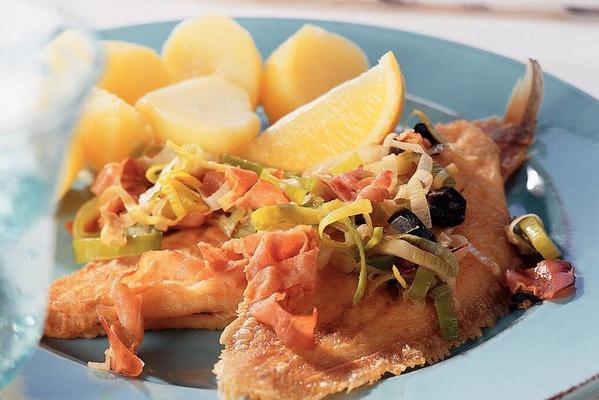 25 minMain dishflour, slip tongues, olive oil, garlic, leeks, raw ham, black olives without pit, lemon,fried sole with ham and leek
25 minMain dishflour, slip tongues, olive oil, garlic, leeks, raw ham, black olives without pit, lemon,fried sole with ham and leek -
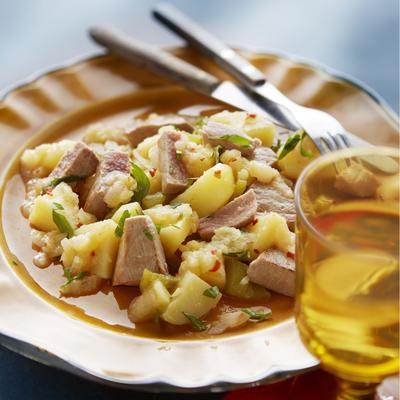 40 minMain dishgreen pepper, extra virgin olive oil, spring / forest onion, garlic, sticking potato, chilli pepper flakes, deep-frozen mine, flat leaf parsley,marmitako
40 minMain dishgreen pepper, extra virgin olive oil, spring / forest onion, garlic, sticking potato, chilli pepper flakes, deep-frozen mine, flat leaf parsley,marmitako -
 65 minMain dishpotatoes, olive oil, onion, garlic, minced beef, sauerkraut, curry powder, sour cream, parsley,potatoes stuffed with sauerkraut beef
65 minMain dishpotatoes, olive oil, onion, garlic, minced beef, sauerkraut, curry powder, sour cream, parsley,potatoes stuffed with sauerkraut beef -
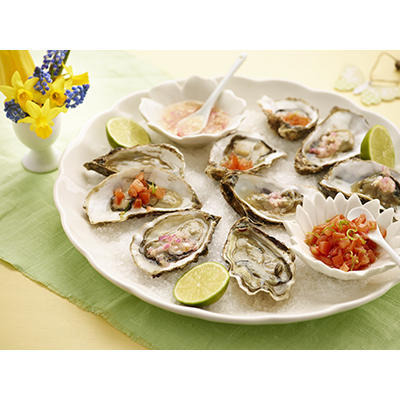 85 minSide dishshallot, White wine vinegar, red silver onions of tomatoes, limes juice and grater, oysters, sea salt,raw oysters with two toppings
85 minSide dishshallot, White wine vinegar, red silver onions of tomatoes, limes juice and grater, oysters, sea salt,raw oysters with two toppings
-
A cup of Tapioca contains about 30 milligrams of calcium. This is about 3% of the recommended daily amount.
-
Again, it's not an impressive amount, but it definitely counts towards your daily intake.
-
Most people eat way too much sodium, or ordinary salt. And I'm not so much talking about that salt pot with the potatoes, but more about all the salt that is processed in processed food. Often a lot of salt is used in sauces, soups and herbs. And how about pizzas, for example? Both frozen and at the pizzeria. A
-
The excess of salt makes up for the lack of flavor. Think about that on your next pizza: If you taste too much salt, and if it is fat, the base product will not taste good at all.
-
Too much salt has long been associated with high blood pressure, heart disease, and strokes.
-
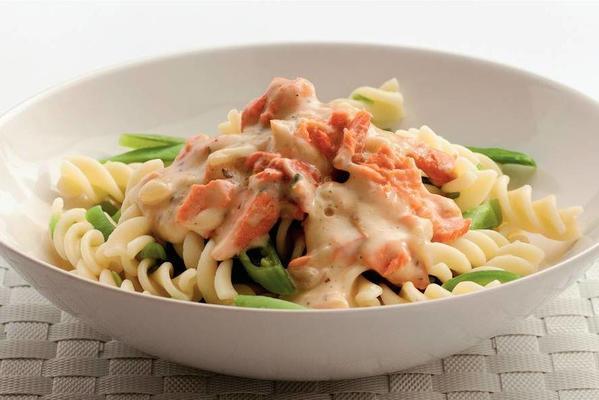 20 minMain dishfusilli, frozen haricot beans, onion, olive oil, semi-skimmed milk, water, mix for tagliatelle cream sauce, pink salmon in a tin,fusilli with salmon and string beans
20 minMain dishfusilli, frozen haricot beans, onion, olive oil, semi-skimmed milk, water, mix for tagliatelle cream sauce, pink salmon in a tin,fusilli with salmon and string beans -
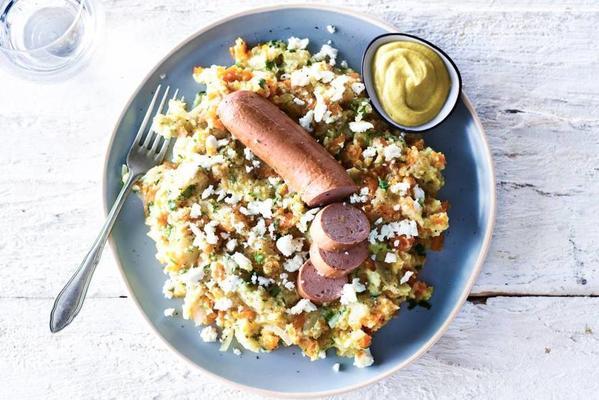 20 minMain dishceleriac, unsalted butter, fine mustard, vegetarian smoked sausage, stew vegetables, fresh parsley, white cheese,celeriac stew with vegetarian smoked sausage (advertorial)
20 minMain dishceleriac, unsalted butter, fine mustard, vegetarian smoked sausage, stew vegetables, fresh parsley, white cheese,celeriac stew with vegetarian smoked sausage (advertorial) -
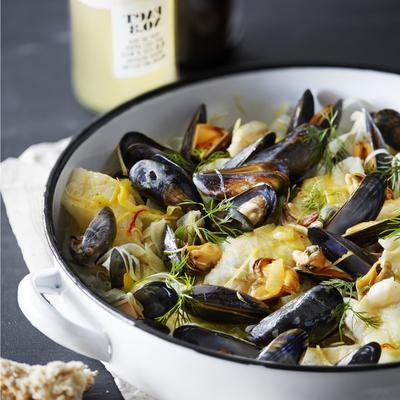 15 minMain disholive oil, onion, fennel bulb, garlic, saffron, lemon, mussel, white beer, fish fillet, butter,fish dish with fennel and white beer
15 minMain disholive oil, onion, fennel bulb, garlic, saffron, lemon, mussel, white beer, fish fillet, butter,fish dish with fennel and white beer -
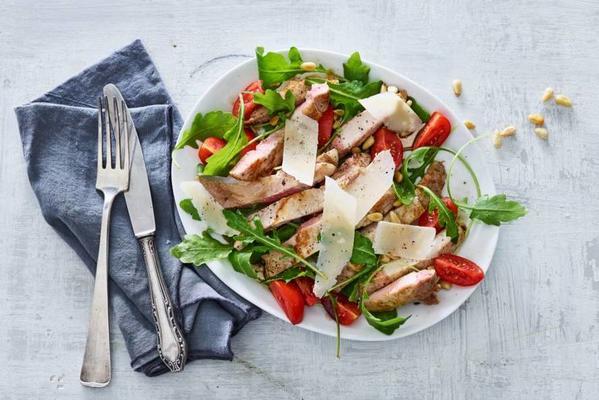 20 minMain dishWorld of meats iberico presca, traditional olive oil, salt, Tabasco, pine nuts, romatomat, arugula, balsamic vinegar, Parmigiano Reggiano,iberico presca tagliata
20 minMain dishWorld of meats iberico presca, traditional olive oil, salt, Tabasco, pine nuts, romatomat, arugula, balsamic vinegar, Parmigiano Reggiano,iberico presca tagliata
-
So good news that Tapioca only contains a tiny bit of salt. Only 2 milligrams per cup.
-
Folate is a B vitamin that your body needs to make DNA. Folic acid is also indispensable for cell division. Folic acid is also crucial for women who want to get pregnant to prevent a spina bifida in a baby, for example. But what many people don't know is that folic acid deficiency can also cause anemia. A
-
One cup of Tapioca contains 6 micrograms of folic acid. That's about 2% of the recommended daily amount.
-
One cup of Tapioca provides no less than 8% of the manganese your body needs every day. Manganese is an essential. Mineral that helps your body metallize carbohydrates, cholesterol, and amino acids. Manganese also supports bone and connective tissue development.
-
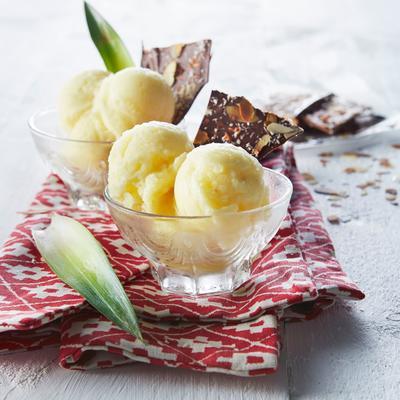 20 minDessertfresh pineapple, dark chocolate, coconut grater, almond shavings, chilli pepper flakes,pineapple sorbet and spicy chocolate
20 minDessertfresh pineapple, dark chocolate, coconut grater, almond shavings, chilli pepper flakes,pineapple sorbet and spicy chocolate -
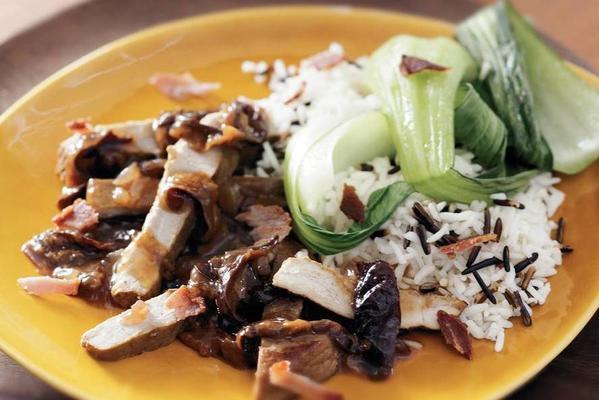 70 minMain dishhampen, Chinese five spice powder, butter, baking bacon, Red onion, garlic, prunes without seeds, cider or apple juice,stewed ham-pieces with prunes
70 minMain dishhampen, Chinese five spice powder, butter, baking bacon, Red onion, garlic, prunes without seeds, cider or apple juice,stewed ham-pieces with prunes -
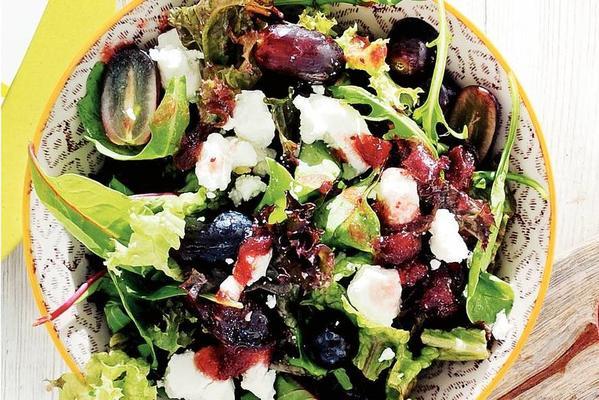 15 minSide dishcranberry compote, Apple juice, extra virgin olive oil, arugula lettuce melange, fresh goat's cheese 55, red grapes,goat cheese salad with grapes
15 minSide dishcranberry compote, Apple juice, extra virgin olive oil, arugula lettuce melange, fresh goat's cheese 55, red grapes,goat cheese salad with grapes -
 10 minSnackfresh raspberry, raspberry, lemon juice, orange juice, Apple juice, powdered sugar,raspberry ice creams
10 minSnackfresh raspberry, raspberry, lemon juice, orange juice, Apple juice, powdered sugar,raspberry ice creams
-
Tapioca is also a good source of iron. One cup of Tapioca contains a whopping 13% of the recommended daily amount. The iron in your body is needed in the hemoglobin. That is a protein that carries oxygen to all parts of your body. If you don't get enough iron, you can develop iron deficiency anemia. This condition, if left untreated, can have very serious consequences. Just think of shortness of breath, general fatigue, and chest pain.
-
The carbohydrates and fiber in tapioca will help fill your stomach. Of course, because they are foods. But the fibers in particular will ensure that your stomach remains full for longer, so that you do not get a 'hunger feeling'. As a result, you will not be tempted to unhealthy snacks, especially in the afternoon. Afternoon is the most dangerous time to fill your stomach with unhealthy snacks. A
-
Eating fiber will help you in every way if you want to lose weight, or if you want to keep your weight in balance.
But beware!
-
This all sounds really good, but there are a few things to keep in mind.
-
If Tapioca is made correctly, there is no problem at all. The problems don't start until you have poor quality Tapioca. If tapioca is made from poorly processed cassava roots, the same Tapioca can even be poisonous.
-
The Cassava root naturally contains a toxic substance called linamarin. This substance is converted in your body into hydrogen cyanide, and can therefore cause cyanide poisoning.
-
Especially in developing countries this can be a problem, especially in times of drought and scarcity. Much less attention is then paid to the processing of the roots, so that there have now been epidemics in African countries. (5)
-
 35 minDessertfirm apple, lemon juice, raisins, chopped walnuts, vanilla sugar, cinnamon, White wine, vanilla bean, milk, sugar, cornstarch, egg yolk,apples from the oven with vanilla sauce
35 minDessertfirm apple, lemon juice, raisins, chopped walnuts, vanilla sugar, cinnamon, White wine, vanilla bean, milk, sugar, cornstarch, egg yolk,apples from the oven with vanilla sauce -
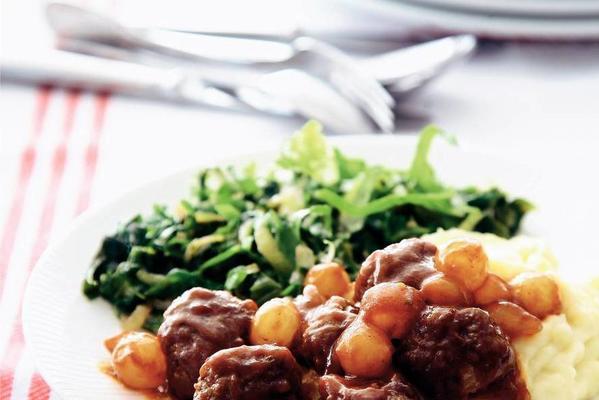 25 minMain dishminced meat, butter, silver onion sweet sour, Ketchup, dark brown caster sugar, cut endive, garlic, mashed potatoes,meatballs with sweet and sour sauce
25 minMain dishminced meat, butter, silver onion sweet sour, Ketchup, dark brown caster sugar, cut endive, garlic, mashed potatoes,meatballs with sweet and sour sauce -
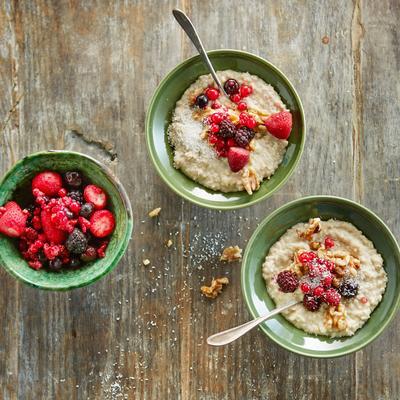 15 minDessertsoy milk, oatmeal, honey, walnut, frozen forest fruits, coconut grater,oatmeal with forest fruits, walnuts and coconut
15 minDessertsoy milk, oatmeal, honey, walnut, frozen forest fruits, coconut grater,oatmeal with forest fruits, walnuts and coconut -
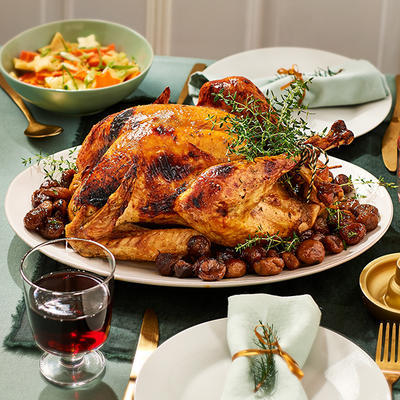 220 minMain dishbacon strips, onion (coarsely chopped), cooked chestnut, lean pork mince, lightly seasoned, Apple, fresh thyme leaf, melted butter, balsamic vinegar, maple syrup or pouring syrup, turkey, at room temperature,stuffed turkey with chestnuts
220 minMain dishbacon strips, onion (coarsely chopped), cooked chestnut, lean pork mince, lightly seasoned, Apple, fresh thyme leaf, melted butter, balsamic vinegar, maple syrup or pouring syrup, turkey, at room temperature,stuffed turkey with chestnuts
-
Rest assured: Commercially produced tapioca normally no longer contains harmful levels of Linamarine, so it is safe to eat.
Finally
-
Tapioca isn't really packed with all kinds of nutrients. In that sense, it is definitely not a superfood. But for people who have health problems with grain and gluten, Tapioca is a great alternative.
-
Have you ever used Tapioca in the kitchen? Leave your experience below!